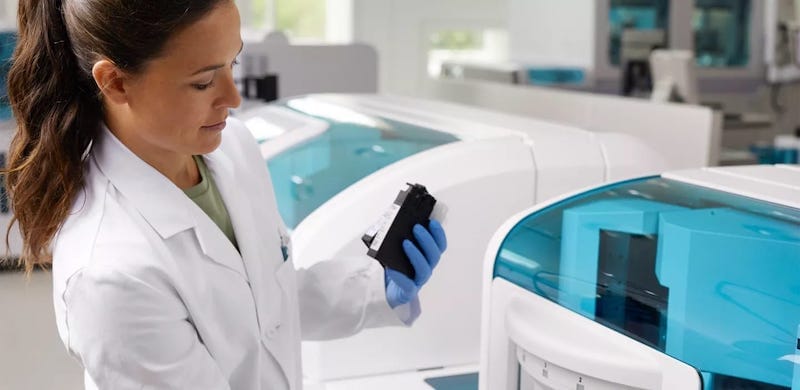Summary: Roche’s Elecsys pTau217 assay received Breakthrough Device Designation, which aims to identify the presence of amyloid pathology in individuals through a blood test, potentially aiding in timely diagnosis and access to appropriate care for Alzheimer’s disease.
Key Takeaways:
- The assay has the potential to provide benefits over existing alternatives for the diagnosis of Alzheimer’s disease.
- The Elecsys pTau217 assay utilizes a biomarker that has shown promise in distinguishing Alzheimer’s disease from other neurodegenerative disorders.
- A positive Elecsys pTau217 result indicates a high likelihood of having a positive amyloid PET/cerebrospinal fluid (CSF) result.
Roche’s Elecsys pTau217 assay, which could help rapidly broaden access to a more timely and accurate diagnosis and potentially mitigate the impact of Alzheimer’s disease, received Breakthrough Device Designation from the U.S. Food and Drug Administration (FDA).
New Blood Test to Mitigate Alzheimer’s
This blood test, which is being developed in collaboration with Eli Lilly and Company, will be used to help identify the presence or absence of amyloid pathology in individuals, which can help ensure they are able to receive appropriate care. This may include participation in clinical trials or access to approved disease-modifying therapies. If approved, the test could help rapidly broaden access to a more timely and accurate diagnosis and potentially mitigate the impact of Alzheimer’s disease on people and society.
“The incidence of dementia is growing worldwide, with 75% of cases remaining undiagnosed.1 Consequently, there is a critical role for Diagnostics to play in addressing this global health challenge,” says Matt Sause, CEO of Roche Diagnostics. “We believe pTau217 is going to be crucial in the diagnosis of Alzheimer’s disease, a condition for which Roche Diagnostics is committed to improving the lives of patients worldwide. We plan to leverage our installed base of diagnostic systems, which is the largest in the world, to ensure we are able to create access to this test for those who need it the most.”
Distinguishing Neurodegenerative Disorders
The pTau217 biomarker, which is a phosphorylated fragment of the protein tau, has shown the ability in research settings to distinguish Alzheimer’s disease from other neurodegenerative disorders and has shown strong performance relative to other biomarkers.2
“The development of the Elecsys pTau217 plasma assay is another milestone in our collaboration with Roche Diagnostics that will advance the Alzheimer’s diagnostic ecosystem,” said Anne White, executive vice president of Eli Lilly and Company and president of Lilly Neuroscience. “We’re excited to help meet the growing need for additional diagnostic tools to enable a timely and accurate diagnosis for people with Alzheimer’s disease.”
As global leaders in Alzheimer’s innovation, Roche and Lilly hope that this collaboration can bring additional speed and scale to testing and diagnosis in this important area of unmet medical need.
Further reading: Roche Showcases New Digital Solutions to Improve Lab Optimization
About Elecsys pTau217
Elecsys Phospho-Tau (217P) is intended to be an in-vitro diagnostic immunoassay for the quantitative determination of the protein Phospho-Tau (217P) (pTau217) in human plasma from individuals aged 60 years and older, according to Roche. The test is intended for use as an aid in identifying amyloid pathology, a pathological feature of Alzheimer’s disease.
A positive Elecsys pTau217 result indicates a high likelihood of having a positive amyloid PET/cerebrospinal fluid (CSF) result, while a negative Elecsys pTau217 result indicates a high likelihood of having a negative amyloid PET/CSF result.
An indeterminate pTau217 result indicates uncertainty on the amyloid PET/CSF result.
The pTau217 result should be used in the diagnostic pathway in conjunction with other clinical information.
Photo courtesy of Roche
References:
[1] Alzheimer’s Disease International. Internet; cited March 24, 2024.
[2] Janelidze et al. Nat Med. 2020;26(3):379-386; Karikari et al. Lancet Neurol. 2020;19(5):422-433; Palmqvist et al. JAMA. 2020;324(8):772-781; Thijssen et al. Lancet Neurol. 2021;20(9):739-752; Mattsson-Carlgren et al. JAMA Neurol. 2023;80(4):360-369





